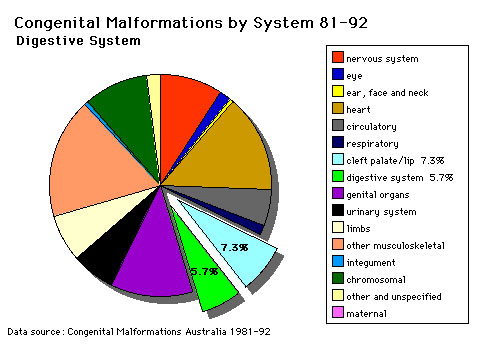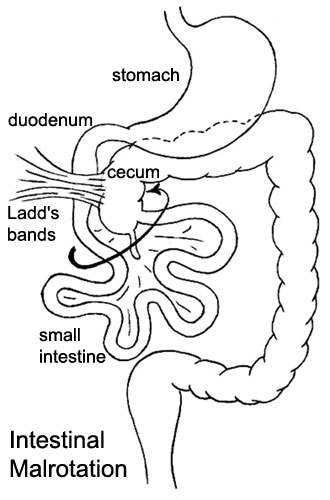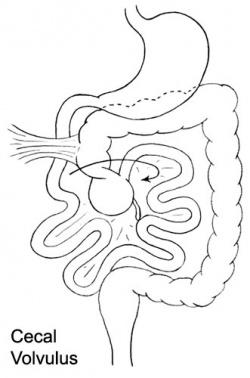Gastrointestinal Tract - Abnormalities: Difference between revisions
| Line 77: | Line 77: | ||
'''Search PubMed:''' [http://www.ncbi.nlm.nih.gov/entrez/query.fcgi?db=PubMed&term=Situs+Inversus+Viscera Situs Inversus Viscera] | '''Search PubMed:''' [http://www.ncbi.nlm.nih.gov/entrez/query.fcgi?db=PubMed&term=Situs+Inversus+Viscera Situs Inversus Viscera] | ||
== Meckel's Diverticulum == | == Meckel's Diverticulum == | ||
Revision as of 00:06, 7 August 2010
Introduction
The "simple tube" of the gastrointestinal tract and its associated organs have many different tract and organ specific abnormalities. Note that as this system begins function (digestively) postnatally, unless there is a determined genetic history within the family, several abnormalities only become evident postnatally. Due to the complex nature (different germ layer contributions, organogenisis) of the growth, elongation and folding of the tract, there are also several mechanical disorders of folding (rotation).
Australian Statistics

The mouth (cleft lip, cleft palate) is part of the digestive tract, but more accurately reflects an abnormality of face formation. |
The pie diagram shows the relative contribution of major gastrointestinal tract abnormalities as a percentage of the total number of congenital abnormalities in Australia beween 1981 - 92.
Note that the digestive system represents approximately 6% of all major congenital abnormalities. One of the most common abnormalities occurring in (2% - 3% population) is Meckel's Diverticulum. |
Some Recent Findings
GIT Lumen Abnormalities
There are two types of abnormalities that impact upon the continuity of the gastrointestinal tract lumen.
Atresia - interuption of the lumen (esophageal atresia, duodenal atresia, extrahepatic biliary atresia, anorectal atresia)
Stenosis - narrowing of the lumen (duodenal stenosis, pyloric stenosis)
Intestinal Malrotation

|
Presents clinically in symptomatic malrotation as:
Neonates - bilious vomiting and bloody stools. Newborn - bilious vomiting and failure to thrive. Infants - recurrent abdominal pain, intestinal obstruction, malabsorption/diarrhea, peritonitis/septic shock, solid food intolerance, common bile duct obstruction, abdominal distention, and failure to thrive. Ladd's Bands - are a series of bands crossing the duodenum which can cause duodenal obstruction. |
Volvulus
Twisting of the midgut (bowel) which causes obstruction to the flow of material. Can include a variable loss of local blood supply which leads to tissue death.

|

|

|
Diagnosis is generally by upper gastrointestinal radiologic examination or less frequently by barium enema or CT scan.
Corrective surgery is generally by the Ladd's procedure, even with surgical treatment there is still significant associated complications and long-term morbidity.
What abnormal embryological processes could interfere with normal rotation and fixation of the gut?
Search PubMed: intestinal+malrotation
OMIM: Volvulus of Midgut
Links: Medlineplus - childhood volvulus | AAFP - Bilious Vomiting in the Newborn | Pediatric education - Neonatal Bilious Emesis |
Situs Inversus Viscera
Disturbance of the lateralisation of the liver may produce transposition of some or all of the foregut and its derivatives.
- Stomach
- Pancreas
- Duodenum - jejunum
- Spleen
- Bile
Also in situs inversus the anatomical relations of the duodenum, pancreas, bile ducts and portal veins may be reversed or disordered.
Search PubMed: Situs Inversus Viscera
Meckel's Diverticulum
This GIT abnormality is a very common and results from improper closure and absorption of the omphalomesenteric duct (vitelline duct) in development. This transient developmental duct connects the yolk to the primitive gastrointestinal tract.
OMIM: Meckel's Diverticulum
Search PubMed: Meckel's Diverticulum | omphalomesenteric duct | vitelline duct |
Note: Bedside Meckel's diverticulum, there are a range of other vitelline duct abnormalities which depend on the degree from a completely patent duct at the umbilicus to lesser remnants (cysts, fibrous cords connecting umbilicus to distal ileum, granulation tissue at umbilicus, or umbilical hernias).
Intestinal Aganglionosis
(intestinal aganglionosis, Hirschsprung's disease, aganglionic colon, megacolon, congenital aganglionic megacolon, congenital megacolon) A condition caused by the lack of enteric nervous system (neural ganglia) in the intestinal tract responsible for gastric motility (peristalsis). In general, its severity is dependent upon the amount of the GIT that lacks intrinsic ganglia, due to developmental lack of neural crest migration into those segments. (More? Neural Crest Abnormalities)
Historically, Hirschsprung's disease takes its name from Dr Harald Hirschsprung (1830-1916) a Danish pediatrician (of German extraction). In 1886, he presented at the German Society of Pediatrics conference in Berlin a case of 2 infants who died of complications of bowel obstruction (H. Hirschsprung, Stuhltragheit Neugeborener in Folge von Dilatation und Hypertrophie des Colons, Jhrb f Kinderh 27 (1888), pp. 1-7). Later autopsies identified a dilatation and hypertrophy of large intestine, and the rectum appeared normally narrow. Hirschsprung suggested that the condition was an inborn disease and named it congenital megacolon.
The first indication in newborns is an absence of the first bowel movement, other symptoms include throwing up and intestinal infections. Clinically this is detected by one or more tests (barium enema and x ray, manometry or biopsy) and can currently only be treated by surgery. A temoporary ostomy (Colostomy or Ileostomy) with a stoma is carried out prior to a more permanent pull-through surgery.
| File:Megacolon stoma1.gif | File:Megacolon stoma2.gif | |
| Ostomy - Aganglionic portion removed | Stoma - intestine attached to the abdomen wall | (Images: NIH - NIDDK - Hirschsprungs) |
| File:Megacolonsurgery1.gif | File:Megacolonsurgery2.gif | File:Megacolonsurgery3.gif |
| Short section of the colon without smooth muscle neural ganglia | Aganglionic segment removed | Reattachment |
OMIM: [../OMIMfind/git/OMIM-142623.htm Hirschsprung's Disease] | [../OMIMfind/git/OMIM-600155.htm Hirschsprung's Disease 2]
Search PubMed: hirschprung's+disease
Links:NIH - NIDDK - Hirschsprungs | MedlinePlus - Hirschsprung’s disease
Gastroschisis
(paraomphalocele, laparoschisis, abdominoschisis, abdominal hernia) A developmental abnormality, which occurs as an abdominal wall defect associated with evisceration of the intestine (2.5 cases/10,000 births), occuring more frequently in young mothers (less than 20 years old). By definition, it is a body wall defect, not a gastrointestinal tract defect, which in turn impacts upon GIT development. Usually occurs as an isolated defect, defects in other organ systems have been reported in up to 35% of children. There are several theories as to the cause of this abdominal wall defect, including recently failure of the yolk sac and related vitelline structures to be incorporated into the umbilical stalk.[1] The condition can often be detected by ultrasound scan.
- Links: Ultrasound movie - Gastroschisis | UCSF Childrens Hospital - Gastroschisis | Brown University Image Bank- Abdominal Wall Defects
Short-Bowel Syndrome
Not generally a developmental abnormality, but related to therapeutic intervention in GIT abnormalities or disease.
Short bowel syndrome is a group of problems affecting people who have had half or more of their small intestine removed. The most common reason for removing part of the small intestine is to treat Crohn's disease. Short bowel syndrome is treated through changes in diet, intravenous feeding, vitamin and mineral supplements, and medicine to relieve symptoms. (NDDIC)
Links: Better Health Short Bowel syndrome | National Digestive Diseases Information Clearinghouse Short Bowel syndrome
Obstetric Cholestasis
A recent paper in the British Medical Journal discusses this pregnancy associated disease.
"Obstetric cholestasis (or intrahepatic cholestasis of pregnancy) remains widely disregarded as an important clinical problem, with many obstetricians still considering its main symptom, pruritus, a natural association of pregnancy. Obstetric cholestasis is associated with cholesterol gallstones. It may be extremely stressful for the mother but also carries risks for the baby." Piotr Milkiewicz, Elwyn Elias, Catherine Williamson, and Judith Weaver BMJ 2002; 324: 123-124
Small Bowel Obstruction
The are two major forms of small bowel obstruction are from either external (extrinsic) or internal (intrinsic) causes. (More? see [#11353110 Boudiaf etal., 2001]) Listed below are a few examples of both causes.
Extrinsic Causes - adhesions, closed loop, strangulation, hernia and extrinsic masses
Intrinsic Causes - intestinal malrotation, Crohn disease, adenocarcinoma, tuberculosis, radiation enteropathy, intramural hemorrhage, intussusception and intraluminal causes.
Necrotizing Enterocolitis
Occurs postnatally in mainly in premature and low birth weight infants (1 in 2,000 - 4,000 births). The underdeveloped gastointestinal tract appears to be susceptible to bacteria, normally found within the tract,to spread widely to other regions where they damage the tract wall and may enter the bloodstream.
Links: Medline Plus - Necrotizing Enterocolitis | Kids Health - Necrotizing Enterocolitis |
Meconium Plug Syndrome
(functional immaturity of the colon) Term used to describe a transient disorder of the newborn colon, which is characterized by delayed passage of meconium (more than 24 to 48 h), intestinal dilatation and yellow/green vomiting. More common in premature infants and can be determined by radiological dye study.
A recent study by Keckler etal., 2008 looked at thecorrelation of meconium plug as identified radiologically covering 1994 to 2007, of 77 patients (mean gestational age 37.4 weeks, birth weight, 2977 g) Hirschsprung's disease was found in 10 patients (13%). "Although all patients with plugs and persistent abnormal stooling patterns should prompt a rectal biopsy and genetic probe, the incidence of Hirschsprung's and cystic fibrosis may not be as high as previously reported."
Links: Keckler SJ, St Peter SD, Spilde TL, Tsao K, Ostlie DJ, Holcomb GW 3rd, Snyder CL. Current significance of meconium plug syndrome. J Pediatr Surg. 2008 May;43(5):896-8.PMID: 18485962 | U Mich - Meconium Plug Syndrome |
Self Assessment Questions
- What is a pharyngeal arch and pouch? List the muscle, arch cartilage and nerves of each arch. List the derivatives of each pharyngeal pouch.
- Describe the main steps in the development of the tongue.
- What are the derivatives of the fore-, mid- and hind-gut?
- What is the buccopharyngeal membrane?
- How does the thyroid gland develop?
- Describe the normal development of the face and palate. List the major malformations of this region and their possible causes.
- How is the liver developed?
- What are the main processes involved in the elongation and rotation of the stomach and intestinal region?
- Describe the development of the pancreas.
- How does the myenteric plexus develop?
- List the basic principles in the development of the peritoneum.
- What are the functions of the liver and pancreas in the fetus? Does the gastro-intestinal tract function in the fetus?
- What are the consequences of malrotation of the gut?
Omphalocele
An abnormality appearing similar to gastroschisis, involves a lack of normal return of the bowel to the abdominal cavity and has a different position relative to the umbilical cord.
References
- ↑ <pubmed>19419415</pubmed>
Reviews
Strouse PJ. [See Related Articles] Animal models of implantation. Reproduction. 2004 Dec;128(6):679-95. Disorders of intestinal rotation and fixation ("malrotation"). Pediatr Radiol. 2004 Nov;34(11):837-51.
Levy AD, Hobbs CM. [See Related Articles] From the archives of the AFIP. Meckel diverticulum: radiologic features with pathologic Correlation. Radiographics. 2004 Mar-Apr;24(2):565-87.
Chitkara DK, Nurko S, Shoffner JM, Buie T, Flores A. [See Related Articles] Abnormalities in gastrointestinal motility are associated with diseases of oxidative phosphorylation in children. Am J Gastroenterol. 2003 Apr;98(4):871-7.
D'Agostino J. [See Related Articles] Common abdominal emergencies in children. Emerg Med Clin North Am. 2002 Feb;20(1):139-53.
Boudiaf M, Soyer P, Terem C, Pelage JP, Maissiat E, Rymer R. [See Related Articles] Ct evaluation of small bowel obstruction. Radiographics. 2001 May-Jun;21(3):613-24.
Articles
<pubmed>19419414</pubmed> <pubmed>17230493</pubmed>
Cassart M, Massez A, Lingier P, Absil AS, Donner C, Avni F. [See Related Articles] Sonographic prenatal diagnosis of malpositioned stomach as a feature of uncomplicated intestinal malrotation. Pediatr Radiol. 2006 Feb 8;:1-3
Ashraf A, Abdullatif H, Hardin W, Moates JM. [See Related Articles] Unusual case of neonatal diabetes mellitus due to congenital pancreas agenesis. Pediatr Diabetes. 2005 Dec;6(4):239-43.
Beaudoin S, Mathiot-Gavarin A, Gouizi G, Bargy F. [See Related Articles] Familial malrotation: report of three affected siblings. Pediatr Surg Int. 2005 Oct;21(10):856-7.
Drewett M, Michailidis GD, Burge D. The perinatal management of gastroschisis. Early Hum Dev. 2006 May;82(5):305-12. Epub 2006 Mar 24.
Vegunta RK, Wallace LJ, Leonardi MR, Gross TL, Renfroe Y, Marshall JS, Cohen HS, Hocker JR, Macwan KS, Clark SE, Ramiro S, Pearl RH. Perinatal management of gastroschisis: analysis of a newly established clinical pathway. J Pediatr Surg. 2005 Mar;40(3):528-34.
Salomon LJ, Mahieu-Caputo D, Jouvet P, Jouannic JM, Benachi A, Grebille AG, Dumez Y, Dommergues M. Fetal home monitoring for the prenatal management of gastroschisis. Acta Obstet Gynecol Scand. 2004 Nov;83(11):1061-4.
Langer JC. Abdominal wall defects. World J Surg. 2003 Jan;27(1):117-24.
Search PubMed
Search Pubmed: gastrointestinal tract abnormalities | intestinal malrotation | Situs Inversus Viscera | Gastroschisis
External Links
Glossary Links
- Glossary: A | B | C | D | E | F | G | H | I | J | K | L | M | N | O | P | Q | R | S | T | U | V | W | X | Y | Z | Numbers | Symbols | Term Link
Cite this page: Hill, M.A. (2024, May 6) Embryology Gastrointestinal Tract - Abnormalities. Retrieved from https://embryology.med.unsw.edu.au/embryology/index.php/Gastrointestinal_Tract_-_Abnormalities
- © Dr Mark Hill 2024, UNSW Embryology ISBN: 978 0 7334 2609 4 - UNSW CRICOS Provider Code No. 00098G
